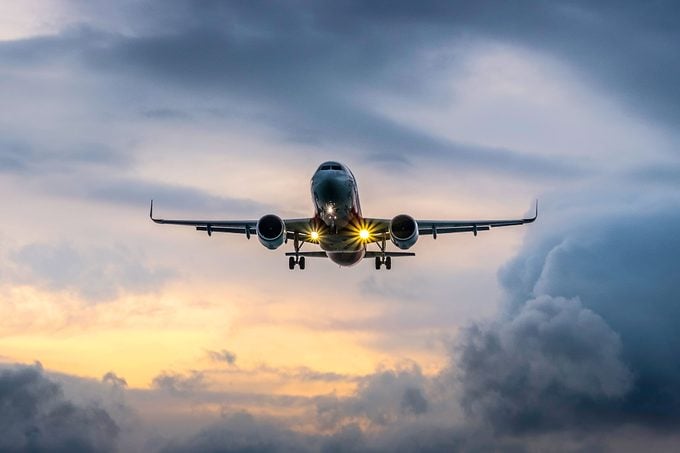This Is What Really Happens When There’s Turbulence
Updated: Sep. 20, 2023
Your airplane is shaking and trembling and even careening to one side. Your cup of water is dangerously close to spilling. Should you be worried?
Forget what you’ll pack in your checked bag. If you’re an anxious flyer, you’re far more concerned about how you’re going to make it from point A to point B without completely freaking out. Throw in a bit of rough weather and the smooth sailing you were crossing your fingers (and toes) for is suddenly out the window. Even though pilots want you to know this truth about turbulence, it can still be frightening and confusing for even frequent fliers. But are those bumps in your airways normal? Are they dangerous? And how do pilots know how to take control, even with planes that mostly, fly themselves? We got an expert to give us the scoop on choppy airplane rides.
What is turbulence?
Pilot Richard Gonzales, an aviation consultant with Briscoe Group, says that put quite simply, turbulence is just “rough air.” The Federal Aviation Administration (FAA) has four levels of turbulence: light, moderate, severe, and extreme. “Light turbulence, often called light chop, feels like rhythmic bumpiness. You won’t have trouble walking around the cabin, and you can expect to see flight attendants out with the service cart. Moderate turbulence has increased bumpiness and will feel more erratic. You might also feel strain from your seat belt. Anticipating this level of turbulence, pilots will turn on the seat belt sign alerting passengers to return to their seats,” Gonzales explains. “Severe turbulence is rare and comes with short bursts of weightlessness and more strain on your seatbelt. During extreme turbulence, the rarest form of rough air, you will experience violent jolts, and objects in the cabin can get tossed around.”
More often than not, though, Gonzales says most passengers will experience only light or moderate turbulence. Find out if planes can fly in extremely cold weather.
What causes turbulence?
Just like a flight can be delayed for a number of reasons, the cause of turbulence is dependent on several factors, from the temperature to the direction that air is blowing. “As the sun comes up and heats the ground, that hot air (called thermals) rises and mixes with cooler air. The two air masses mixing creates an imbalance, which results in rough air. This type of turbulence typically happens closer to the ground. If you’ve ever flown into Las Vegas or Phoenix, you might have felt a bumpy approach due to the desert ground pushing hot air upward,” Gonzales says.
Turbulence can also happen when something gets in the way of airflow. Anything from a tall building and mountains to trees can impact the way passengers feel aboard the airplane. “As air flows horizontally, anything in its way causes a disruption leading to rough air. Depending on the aircraft’s altitude, crossing the Rockies will most likely bring turbulence,” he explains.
If you’re going across the country or from one climate to another, you’re probably more likely to experience some sort of turbulence. As Gonzales notes, colliding a warm front with a cool front causes uneven air, because they both have different directions and speeds. Don’t miss these answers to other airplane-related questions you’ve always had.
Is turbulence dangerous?

More often than not, Gonzales says turbulence is super normal, and while you may be uncomfortable, you’re most likely safe. “Pilots use preflight weather briefings to detect turbulence along their route of flight. Once airborne, pilots will receive ‘ride reports’ from other aircrew who encountered rough air, so they have time to coordinate a path around the turbulence,” he explains. “In all, there’s a robust network of weather experts, air traffic controllers, and pilots working together to ensure the smoothest flight for everyone. Sometimes it’s unavoidable to fly through light and moderate turbulence, but rest assured your pilots are working to find smooth air. If they encounter severe or extreme turbulence not forecasted, pilots will quickly climb or descend to a safe and smooth altitude.”
What should you do during turbulence?
If you’re stressed while flying, whether it’s under sunny skies or in a rainstorm, Gonzales says to use body language skills to put yourself at ease. Specifically, take a look at flight attendants when turbulence is going down. He says if they’re relaxed and continuing their cart service, it’s nothing to be worried about. Another option is to take a look at the passengers in front of you: “Gauge the bobbling heads in front of you. While funny to watch, it’s also a good indicator of rough air. If the turbulence gets serious, you’ll see those passengers who didn’t fasten their seat belts come up out of their seats. In this example, expect your pilots to climb or descend and get to smoother air,” he notes.
If the ride is really rough, ease into the feeling as much as you can and keep your seatbelt on. “When you encounter rougher air, you could feel weightless (think the drop on a roller coaster) or a hard pull on your seatbelt,” he says. “Remember, pilots and flight attendants want passengers to enjoy their flight and understand the uneasiness turbulence causes.” Whatever you do, just avoid doing these things on a plane.
